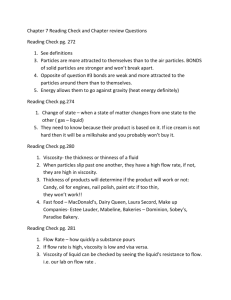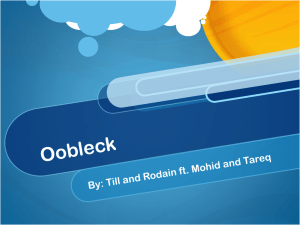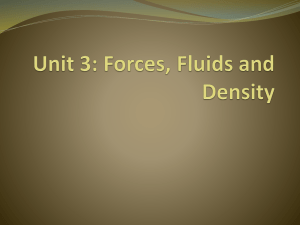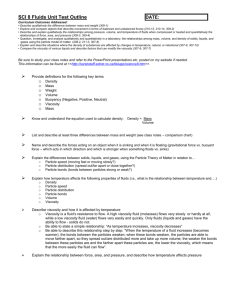The Incredible Goo
advertisement
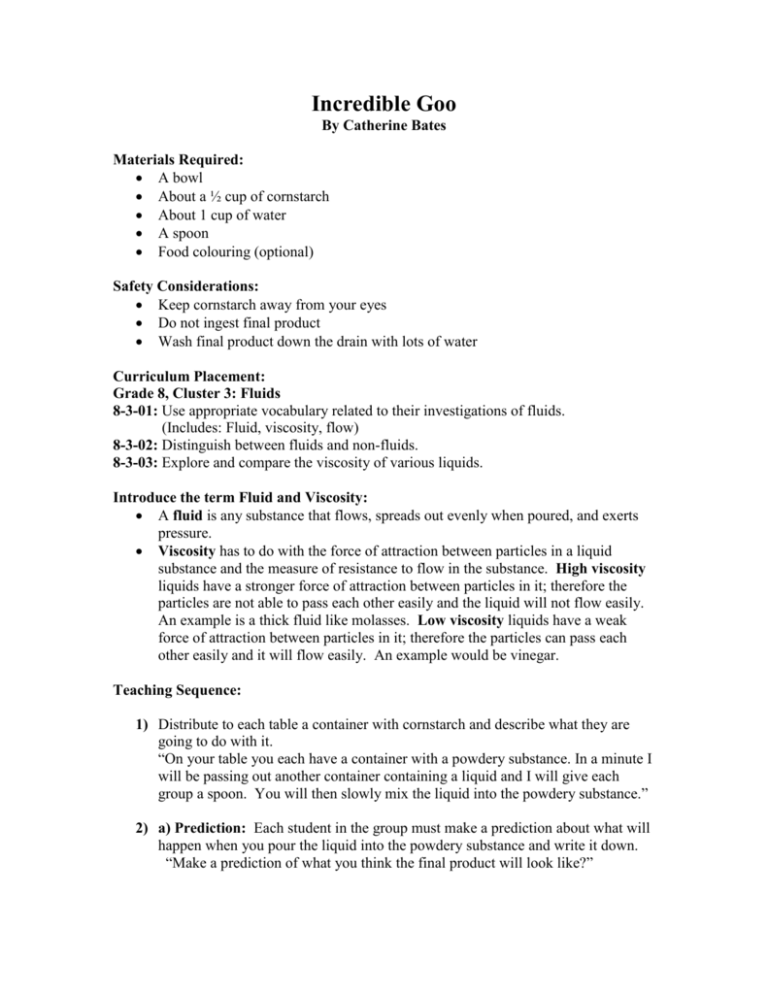
Incredible Goo By Catherine Bates Materials Required: A bowl About a ½ cup of cornstarch About 1 cup of water A spoon Food colouring (optional) Safety Considerations: Keep cornstarch away from your eyes Do not ingest final product Wash final product down the drain with lots of water Curriculum Placement: Grade 8, Cluster 3: Fluids 8-3-01: Use appropriate vocabulary related to their investigations of fluids. (Includes: Fluid, viscosity, flow) 8-3-02: Distinguish between fluids and non-fluids. 8-3-03: Explore and compare the viscosity of various liquids. Introduce the term Fluid and Viscosity: A fluid is any substance that flows, spreads out evenly when poured, and exerts pressure. Viscosity has to do with the force of attraction between particles in a liquid substance and the measure of resistance to flow in the substance. High viscosity liquids have a stronger force of attraction between particles in it; therefore the particles are not able to pass each other easily and the liquid will not flow easily. An example is a thick fluid like molasses. Low viscosity liquids have a weak force of attraction between particles in it; therefore the particles can pass each other easily and it will flow easily. An example would be vinegar. Teaching Sequence: 1) Distribute to each table a container with cornstarch and describe what they are going to do with it. “On your table you each have a container with a powdery substance. In a minute I will be passing out another container containing a liquid and I will give each group a spoon. You will then slowly mix the liquid into the powdery substance.” 2) a) Prediction: Each student in the group must make a prediction about what will happen when you pour the liquid into the powdery substance and write it down. “Make a prediction of what you think the final product will look like?” “Based on the definition of viscosity, do you think the final product will have a high viscosity or a low viscosity? Write down your prediction.” b) Get students to share their predictions with the rest of their group. “Now share your predictions with your group and see if anyone else made the same prediction as you.” c) Ask a student to share their prediction of what they think will happen. 3) a) Hand out a container of liquid and a spoon to each group. b) Have students pour the liquid slowly in to the container with the powdery substance. “Now slowly pour a little liquid into the container and then stir it until the liquid has been mixed in. Keep pouring a little liquid in and stirring it until the powder is totally saturated with water and you can’t mix it anymore. In other words it should no longer look like a powdery substance.” 4) a) Ask the students about what they observed while they were mixing the liquid into the powder and what they think the viscosity of the final product is. “What did you observe when you mixed the liquid into the powder?” “Does the final product appear to have a high or low viscosity?” b) Have the students pour the new liquid substance out of the container and onto the table. Get them to poke their finger into it quickly and then slowly. Then get them to pick the substance up in their hands and try to form it into a ball and then let it just sit in their hands. “Now pour the new substance out of the container and onto the table. Record what you observe.” “Poke your finger into the substance quickly and then poke it slowly and record what you observed or felt.” “Now pick the substance up and squish it into a ball. Then just let it sit in your hand. What happened to the substance?” c) Pick a couple of students in the classroom to share their observations with the class. 5) Ask a couple of the students to try to explain what has occurred and why the substance reacted like it did when they were touching it. “What do you think occurred to the substance to make it react like it did?” 6) Explanation: The powdery substance, which is cornstarch, contains tiny grain particles. When the cornstarch is mixed with the right amount of water and then poured out of the container it appears to be a low viscosity liquid because the grain particles are spaced out in the liquid and it poured out easily. When pressure was applied to the substance in any way, whether it was pressing your finger firmly and quickly into it or squishing it into a ball, it felt like a solid. This occurs because the grain particles are being compressed together and this causes them to stick to each other. When the substance is no longer being compressed or squeezed, the grain particles in the liquid will spread apart again causing the substance to take on a liquid form once more. This is why the substance oozed through your fingers when you stopped squeezing it. Bloom’s Taxonomy: 5 Questions for Supporting Class Discussion or Independent Study 1) Knowledge: What is the definition of viscosity? 2) Comprehension: In your own words describe why the mixture could act like both a liquid and a solid. 3) Application: Place these four substances, shampoo, honey, ketchup and apple juice, in order from highest to lowest viscosity. Explain your answer. 4) Analysis: Draw a diagram for the substance with the highest viscosity and one for the substance with the lowest viscosity, from the previous question, to help explain what the particles or molecules will look like in these substances. Be sure to label the different parts of your diagram. 5) Synthesis: Come up with a substance with a high viscosity and one with a low viscosity which can be found in nature. Resources: Ellis-Christensenk, T. (2007). Wise Geek. What is Viscosity. Retrieved October 3, 2007, from http://www.wisegeek.com/what-is-viscosity.htm Public Broadcasting Council. (2002). 60 Second Science. Cornstarch and Water. Retrieved September 17,2007, from http://60secondscience.org/activities/cornstarchAndWater.html *I got the idea for this discrepant event from a grade eight classroom I was a teacher assistant in. I wasn’t to sure what the students were using for the experiment, so I tried a couple different powders, like baking soda and baking powder, at home until I found out that it was cornstarch because the final product looked and reacted in the same way as the substance that the students made.



